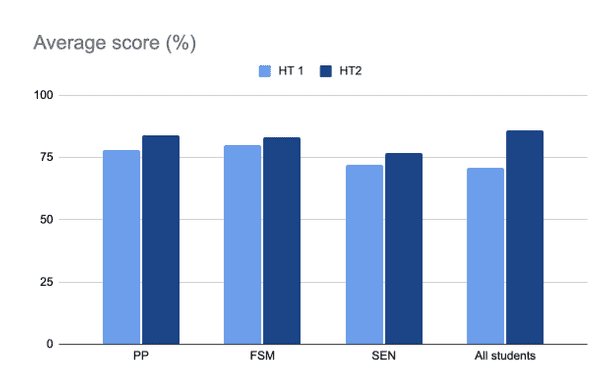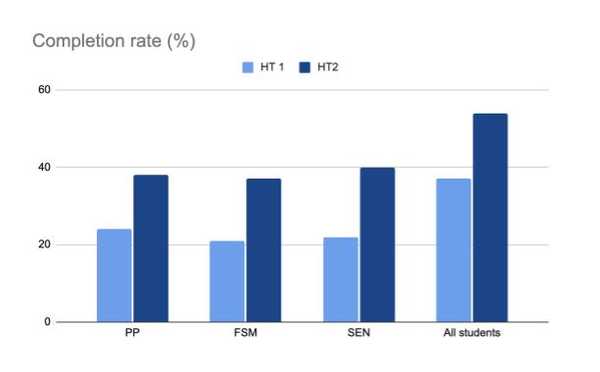

How we use technology to boost learning of our PP and SEN students
Halewood Academy is a mixed 11-16 academy in Knowsley, near Liverpool. We are part of a Multi-Academy Trust consisting of four secondary schools and four primary schools in the Merseyside region. The Academy is situated at the heart of a close-knit community meaning we rely on strong relationships with our students to allow them to thrive. We have approximately 1100 children on role currently and above national average rates of PP and SEND in our cohort: 48% and 21% respectively.
I am responsible for homework in the English department at Halewood. I joined in 2019 as a Teach First Leadership Development Programme participant and had a baptism of fire in terms of dealing with the COVID-19 lockdown in my first year! Incidentally, while the pandemic itself impacted classroom learning to a huge extent, it presented an opportunity for us in terms of ensuring students were able to access online learning at home. This meant that once we had returned to the classroom, we had new prospects in terms of homework.
When I started at Halewood in 2019, teachers had previously set homework on an individual class basis, but this meant that students in different classes were receiving a different academic diet. To combat this, we began using homework booklets that complemented schemes of learning. They were given out once a half term and marked by the teacher at the end of that period. Unfortunately, this presented yet more obstacles: students lost booklets, damaged booklets, forgot booklets, required additional teacher support – all of this before we added a metric tonne of marking to teachers’ already hefty workloads! When we returned to school in 2021, it was clear that we needed a new solution, and serendipitously, we now had an entire school cohort able to access online learning.
Our science department had already been using Seneca with mixed success before 2020 so my head of department, Andrea Gilbert, decided to trial it. After a cross-curricular link-up, I started setting homework on Seneca on a regular basis. The abundance of available assignments that match up with our schemes of learning was convenient. I would set homework and then check who had done it and what they scored once the assignment date passed – no teacher marking!! When we first started, there was some housekeeping in terms of ensuring each student had codes to access the work that their teacher had set. This was negated later when the classes were synced with our SIMS database making it even easier for the children to access; even new starters or students that moved classes. Currently, I set the homework for all the year groups and then individual class teachers check it and give reward points (or negative marks) based on students’ efforts. If a student does not attempt or fails to engage with the material, the class teacher can then re-assign at their own discretion.
Seneca also offers easy-to-run reports that allow us to analyse data that can inform practice at a classroom or cohort level. After analysis, we realised that the data shows great progress in a short period of time. In the first half term of the current academic year, the data showed that only 37% of our students were completing their Seneca assignments and their average score was 81%. Fortunately in the second half term, the numbers jumped to 54% completion rate and 86% average score!
It is key to note that this was a widespread improvement that was mirrored in our key cohorts. For example, our Pupil Premium went from 24% to 38% completion rate and from 78% to 84% average score. Our FSM students went from 21% to 37% completion rate and from 80% to 83% average score. Lastly, our SEN students went from 72% to 77% completion rate and from 19% to 38% average scores. In addition,many of our SEN students say they appreciate Seneca as they are able to work at their own pace and are given immediate feedback.
Of course, some students always show some reluctance to do anything outside of a classroom, but with Seneca that is more easily monitored. I know, to the nearest second, how long my pupils have spent on their assignments. This avoids the ‘I did it, I just forgot it’ excuse, too! Some students also seek out study topics in their own revision time; anything that helps my Year 11s memorise Romeo and Juliet quotes is an asset in my eyes. I firmly believe that when utilised correctly Seneca is an excellent addition to a teacher’s toolkit.
Article written by Ms Emma Byron-Bentley, from the English Department at Halewood Academy.
To try Seneca with your students, visit senecalearning.com
To enquiry about syncing your school's management system with Seneca and generating whole-school reports, book a call with us.







